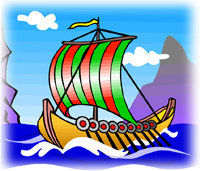
Worksheets and No Prep Teaching Resources
Reading Comprehension Worksheets
Canadian Theme Unit

Canadian Theme Unit
 Worksheets and No Prep Teaching Resources Reading Comprehension Worksheets Canadian Theme Unit |
 Canadian Theme Unit |
| edHelper's suggested reading level: | grades 3 to 5 | |
| Flesch-Kincaid grade level: | 3.86 |
|
Canada's Vikings
By Mary Lynn Bushong |

|
 1 Imagine you are on a Viking ship. The large square sail is full as the wind pushes the ship through the water. The narrow prow cuts through the waves, while the light hull makes the ship ride lightly on the water's surface.
1 Imagine you are on a Viking ship. The large square sail is full as the wind pushes the ship through the water. The narrow prow cuts through the waves, while the light hull makes the ship ride lightly on the water's surface. |
Create Weekly Reading Books
Prepare for an entire week at once! |
| Leave your feedback on Canada's Vikings (use this link if you found an error in the story) |
 |
Canadian Theme Unit
|
 |
Social Studies
|